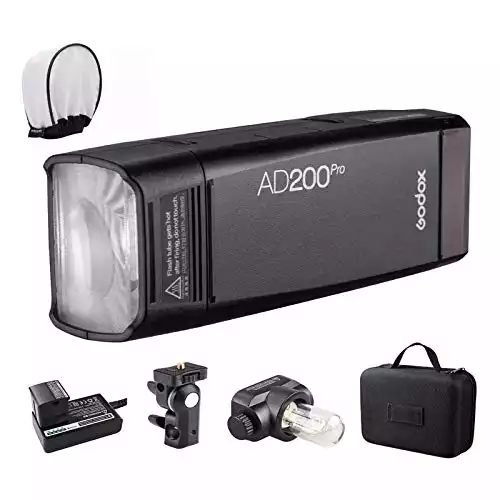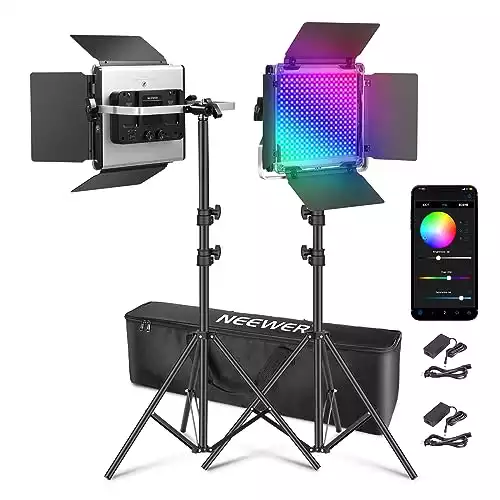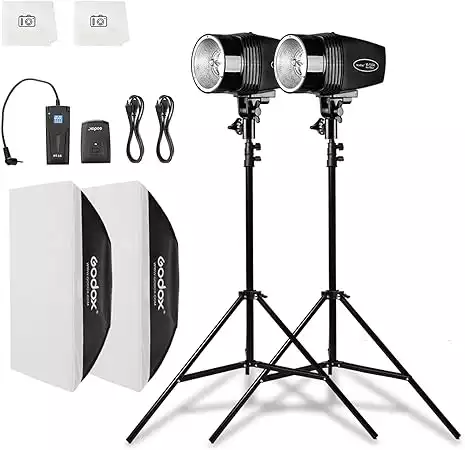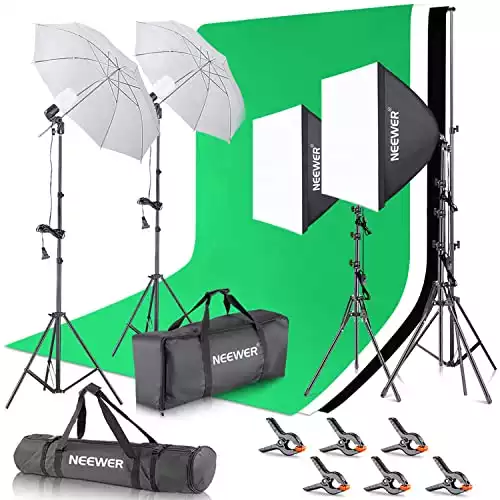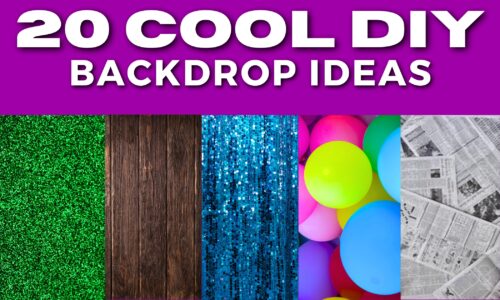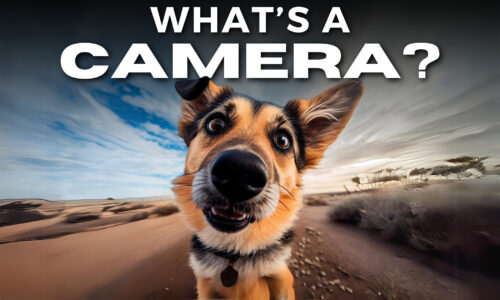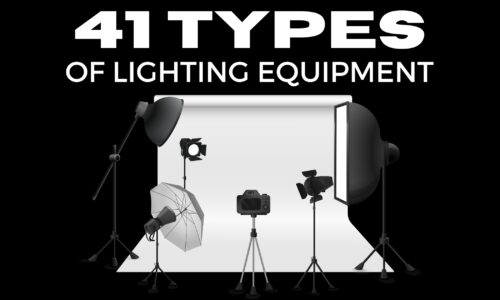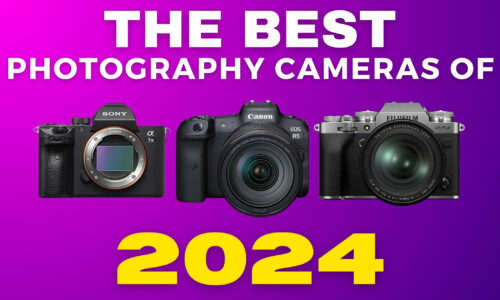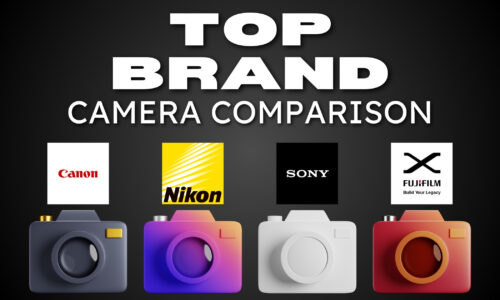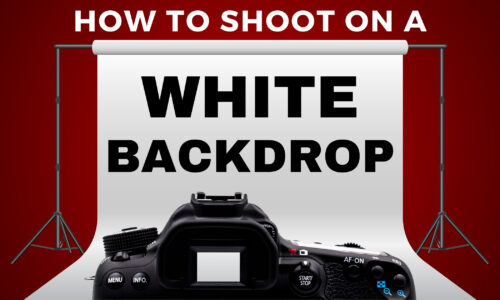The 3 Best Photography Lighting Kits for Taking Photos
Choosing the best photography lighting kit for your studio or locational shoot means finding the best fit based on your experience and the photoshoot you’re about to have.
It also means considering your camera and intended use, budget, lighting kit features, and the type of photography you wish to pursue.
Plus, a reliable photography lighting kit should not only help you take great photos but also last you years.
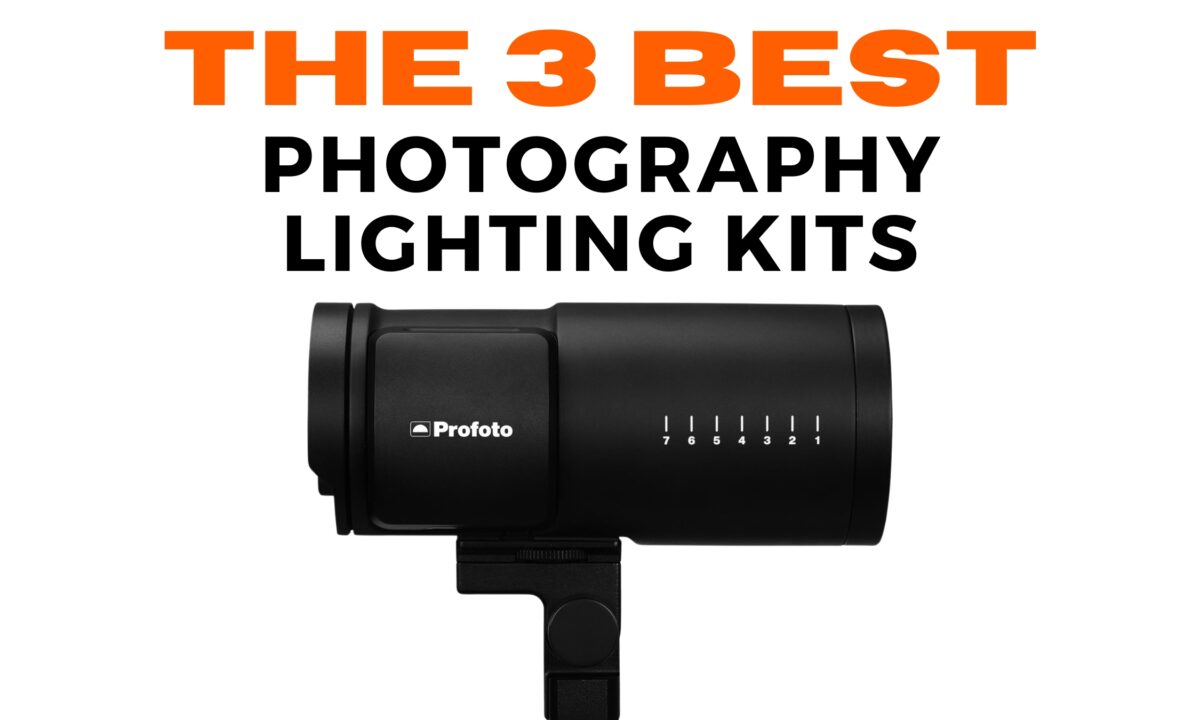
With that in mind, our picks for the best photography lighting kit are:
- Godox AD200 Pro (our favorite)
- Neewer 660 RGB (for beginners)
- Profoto B10 (for professionals)
What Is The Best Photography Lighting Kit?
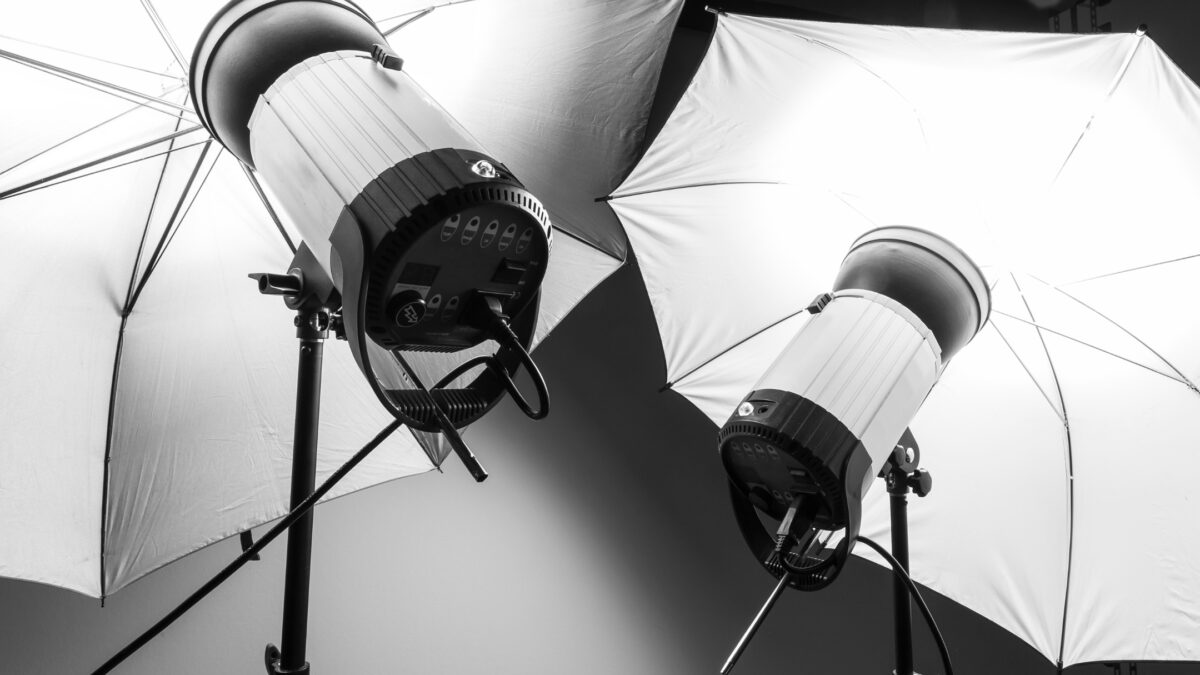
There is no one best photography lighting kit.
That’s why we recommended 3 different ones based on your shooting needs and experience level. And, in photography, natural light is often preferred.
However, natural light can be unpredictable and hard to control.
You might find yourself needing consistency for shooting various subjects, like products or people, without waiting for the perfect lighting conditions.
That’s where studio lights come in handy.
They offer control and can produce natural-looking results with the right accessories and techniques.
As you consider various kit options, think about the types of photography you’re most involved in. Do you require continuous lighting for video shoots, or are you focusing on still photography with flash units?
Consider the amount of power you’ll need and the ease of use and adjustability of the light sources.
The Best Photography Lighting Kit: Godox AD200 Pro
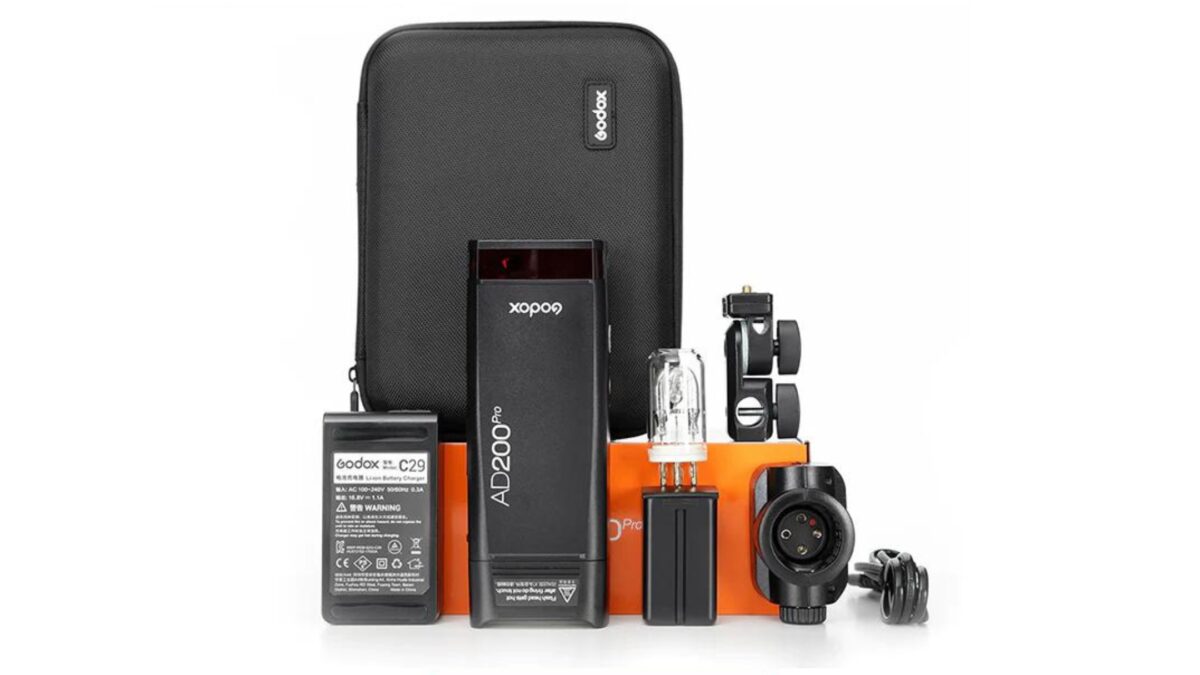
If you’re looking for a versatile, powerful, and compact lighting solution for your photography needs, then the Godox AD200 Pro is what you need.
Recognized as one of the best photography lighting kits for professionals and beginners, this flash strobe has a lot to offer.
It’s also our favorite and what we use the most in our studio here in Connecticut.
The Godox AD200 Pro is packed with features to help you achieve the perfect lighting for your shots. With 200Ws of power, you’ll have plenty of flexibility when it comes to adjusting your lighting. The unit is also compatible with most major camera brands and comes equipped with both a bare bulb and a speedlite fresnel flash head, so you can choose the light type that best suits your needs.
One of the standout features of the AD200 Pro is its high-speed sync capability. With sync speeds of up to 1/8000 of a second, you can capture impressively sharp images even in challenging conditions. This feature, combined with front and rear curtain sync, will take your pictures to a new level.
Another aspect that makes the Godox AD200 Pro a top choice is its incredible battery performance. With a 2900mAh battery, you can expect up to 500 full power flashes on a single charge. Plus, the 0.01 to 1.8 seconds recycling time means you’ll be able to take your shots quickly and efficiently.
The Godox AD200 Pro isn’t just powerful – it’s also lightweight and compact.
This makes it easy to transport and set up, especially when compared to traditional studio flash units. So whether you’re working in a studio or on location, the AD200 Pro can handle it.
Best Photography Lighting Kit for Beginners: Neewer 660 RGB Lighting Kit
If you’re just starting out in photography and need a reliable lighting kit, the Neewer 660 RGB Led Video Light with APP Control is a nice pickup. This lighting kit strikes a good balance between performance and affordability, making it ideal for all your photography needs. Let’s take a closer look at its features.
One of the main reasons this lighting kit stands out is its remarkable color performance.
The Neewer 660 RGB provides a color rendering index (CRI) of 97+, ensuring the colors in your photos and videos appear vibrant and true to life. And with 360° full-color options and easy app control, you can adjust the hue and saturation to achieve the perfect look for your shoot.
Another important feature of the Neewer 660 RGB kit is its versatile application.
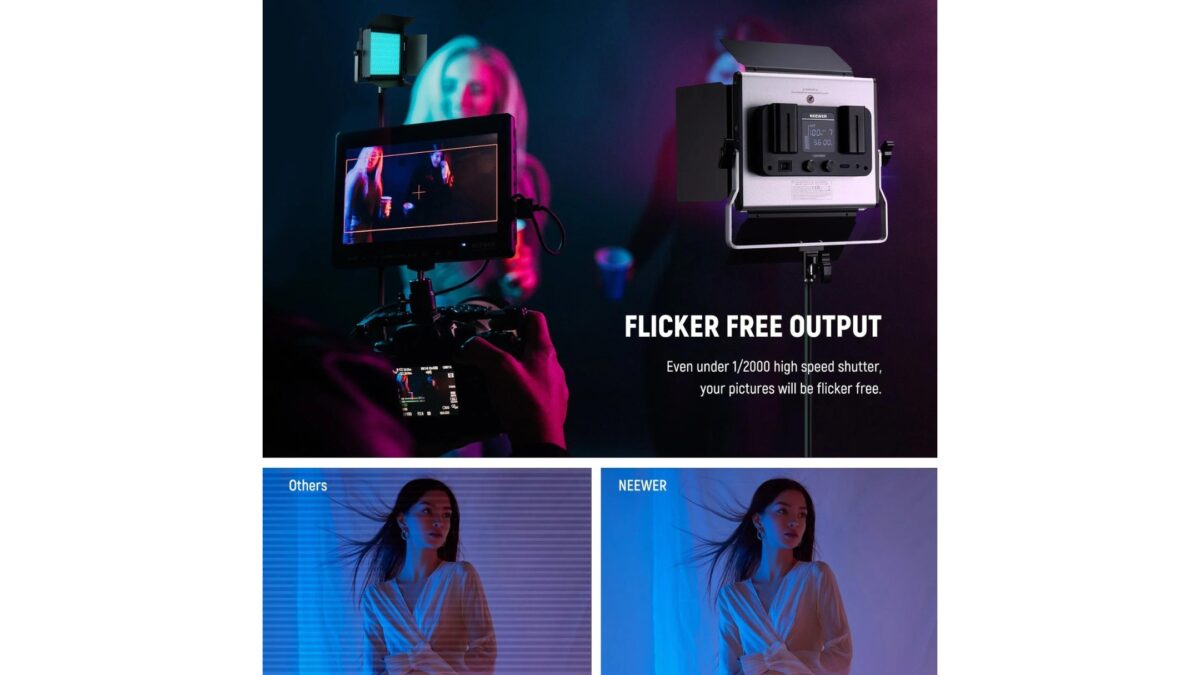
You can use it for a range of photography-related activities, from photos to gaming, streaming, YouTube, Webex, broadcasting, and web conferences. This kit comes with a convenient U bracket and barndoor attachments, allowing you to control the direction and spread of the light effectively.
And the app control feature is particularly handy for beginners.
It lets you remotely adjust the brightness, color temperature and even choose from 9 pre-set lighting scenes. That way, you don’t have to worry about constantly adjusting the light manually during a shoot, allowing you to focus more on capturing photos.
Best Photography Lighting Kit for Professionals: Profoto B10 Lighting Kit
When it comes to professional photography lighting, the Profoto B10 Lighting Kit stands out as one of the top choices.
With its compact size and powerful output, this kit offers the perfect combination of portability and performance, making it a go-to option for many professional photographers.
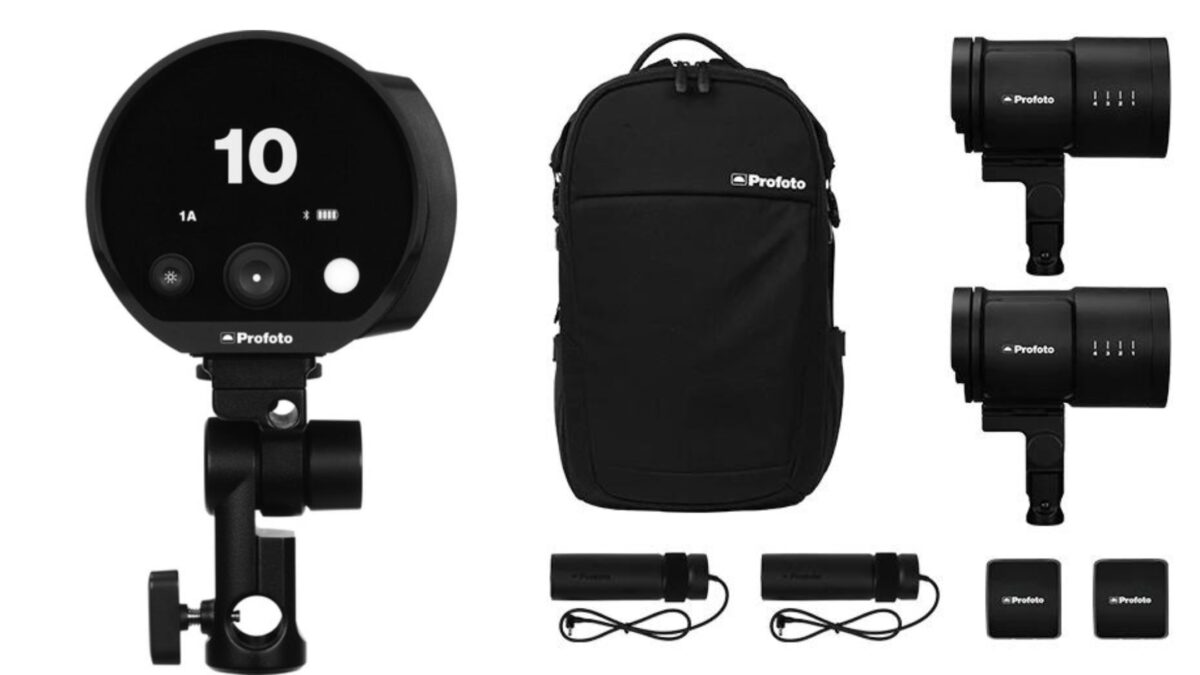
The Profoto B10 is designed to be as portable as a medium-sized camera lens, allowing you to easily carry it along with your other gear. And despite its small size, it packs a punch with a light output equal to five speedlights, ensuring you have a powerful and versatile source of light for your photography.
One of the standout features of the B10 is its wireless connectivity.
Thanks to Profoto AirX technology, you can seamlessly connect the B10 to your camera, smartphone app, or other Profoto devices, letting you to work quickly and efficiently. The B10 is also compatible with over 120 different light shaping tools, so you can find the perfect setup for any shoot.
When shooting video, you’ll appreciate the B10’s continuous light feature.
Both brightness and color temperature are easily adjustable to blend with ambient light, and the LED lamp provides a high-quality, color-balanced light source. The B10 is lightweight enough to be used handheld or mounted on a tripod or light stand, providing flexibility for your shoots.
Profoto has even designed the B10 with ease of use in mind.
The minimal interface makes it simple to get started, and battery management is quick and efficient. With the Profoto Control app, you can control the B10’s settings from your smartphone and install updates in seconds. Profoto also offers many different B10 kit options.
Why Invest in a Photography Lighting Kit?
A photography lighting kit can significantly enhance the quality of your work, allowing you to capture images that appear professional and visually appealing.
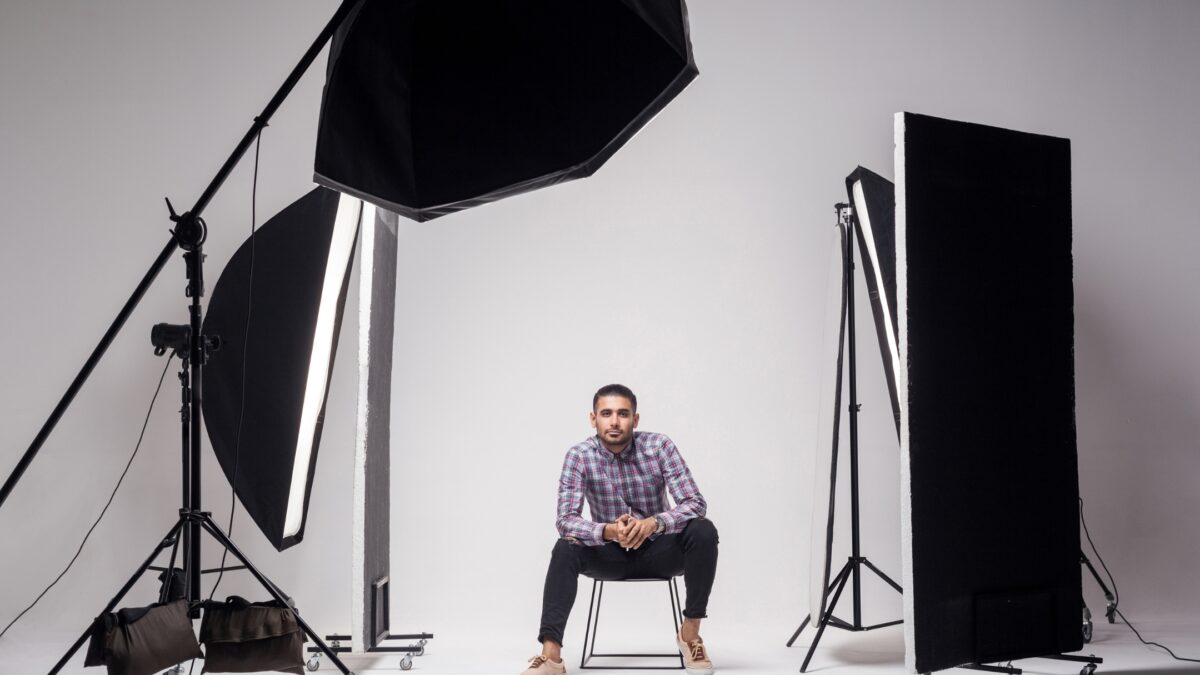
By investing in a lighting kit, you gain the ability to control the light in your photographs, influencing mood, texture, and other key visual elements.
Another major advantage of investing in a photography lighting kit is versatility. With different types of lighting equipment, such as continuous lighting kits, you can easily visualize and adjust how the light affects your image before you start shooting.
This enables quick fine-tuning and saves you time during the editing process.
Another reason to invest in a photography lighting kit is its potential to uplift your creativity and technical skills. By experimenting with various lighting setups and understanding how to manipulate light, you’ll develop a strong foundation in photographic techniques.
Plus, well-lit subjects and scenes tend to draw more attention. Making your work stand out among the other photographers.
This kit is designed for beginners and offers straightforward setup and use, along with powerful, adjustable lighting.
Finally, a good lighting kit can be adaptable to various photography genres such as portraits, product photography, and still life.
This means you’re investing in equipment that supports a variety of photography styles, allowing you to take on diverse projects or expand your skills.
Understanding Photography Lighting Kits
Photography lighting kits are necessary tools for both professional and novice photographers. They can transform your photography setup, making it easier for you to achieve your desired lighting effect.
Let’s look at what these kits typically include and how they can enhance your studio or location shoots.
A photography lighting kit often comes with various components. These may include light stands, accessories like softboxes or umbrellas, and the lights themselves. Some kits even provide carrying cases for convenient transport and storage.
The primary goal of lighting kits is to offer you a versatile and comprehensive lighting solution, no matter what your photography needs are.
When browsing different photography lighting kits, consider your specific requirements, such as the type of photography you do and where you plan to shoot. For example, if you often work in a studio setting, a kit with sturdy light stands and numerous accessories might be a better fit.
But, if you frequently shoot on-location, portability and battery-powered lights should be high on your priority list.
As you set up your photography lighting kit, remember the positioning of your light sources significantly impacts the final results. Mastering the proper placement of your lights will help you achieve various effects like adding depth, contouring your subjects, or creating a specific mood.
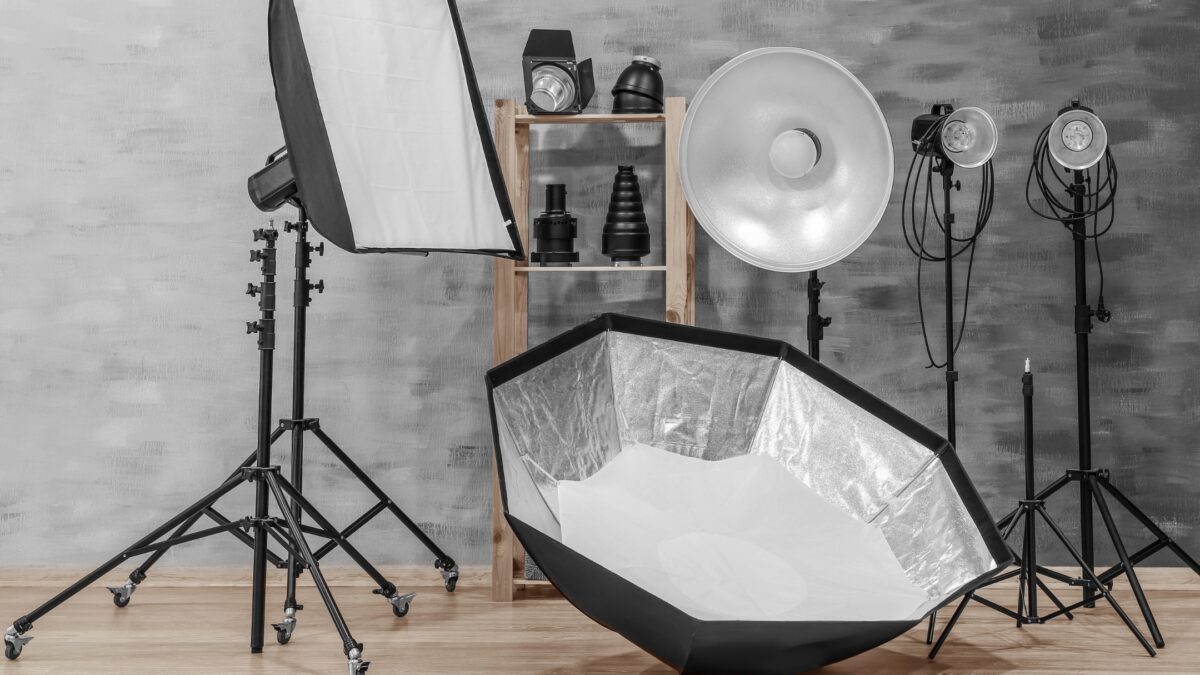
To improve your lighting setup further, consider using additional accessories.
Softboxes and umbrellas can help you diffuse the light, creating a softer and more natural feel. And reflectors can redirect light onto specific areas of your subject or scene so you get the look you want.
Types of Photography Lighting
When it comes to photography lighting, there are several types of equipment and techniques to choose from. Knowing your options can help you with your selection and photography.
Continuous Light: These are lights that remain on throughout the entire shoot. They provide soft, constant illumination. They often use light bulbs and can be combined with modifiers to control the direction and intensity of the light. Continuous lights are a great way to get started with studio lighting because you can see exactly how the light affects your subject.
Flash: Flashes provide a brief burst of light, often referred to as strobe lighting. They can be either manual or TTL (through-the-lens) metering systems. Manual flashes give you full control over the power output, while TTL flashes automatically adjust the power based on the camera’s settings. Full-power flashes can offer a lot of versatility in terms of power and light-shaping options.
Natural Light: Before adding any artificial light to your setup, you should master the use of natural light. This refers to the light provided by the sun and moon. It’s constantly changing depending on the time of day and weather conditions, which means you gotta learn how to adapt and make the most of the available light.
What to Look For in a Photography Lighting Kit
Let’s discuss some key factors you should keep in mind when searching for the perfect lighting kit for your needs.
First and foremost, consider your budget.
Photography lighting kits come in a wide range of prices, so find one you can afford. You can find more affordable options like the Neewer 600W Battery Powered Lighting Kit. Or invest in higher-end models, depending on your needs and available funds.
Next, think about size and portability.
If you’re typically shooting on location or in tight spaces, you’ll want a compact and lightweight kit that’s easy to set up and transport.
Grab two Godox AD200 Pros or kits like the Westcott FJ400 Strobe 1-Light Backpack Kit (which we also love). It’s designed specifically for location photography.
The wireless capabilities of a lighting kit are also important, especially if you want to avoid cluttered lighting setups and go cable-free. Look to invest in a lighting kit that offers wireless features.
This makes it easier to position your lights without worrying about tripping over cords or finding an electrical outlet.
Many modern lighting kits offer this feature, so be sure to check the product descriptions for this feature before buying.
As you’re shopping for a photography lighting kit, keep your experience level in mind.
The Neewer lighting kit is designed for superior photo studio quality, ensuring well-lit, professional-looking photos and videos in a variety of settings.
Beginners benefit from kits that include easy-to-use, versatile lighting options such as continuous LED lights or umbrella lights. These setups are often more forgiving and easier to learn with. But, if you’re an experienced photographer, get the more advanced lighting kits.
They provide you with more precise control over light output, such as Profoto B10 or flash kits like the Elinchrom D-Lite RX 4/4 Softbox To Go Kit.
And finally, make sure the kit you choose will suit your specific photography niche or shooting style.
For example, if you primarily shoot portraits, you’ll want to look for a kit that includes softboxes or diffusers to create flattering, even lighting. And if you mainly shoot product photography, a lightbox setup might be more appropriate to provide consistent, controlled lighting.
Location and Portability
When it comes to location and portability, a crucial aspect for photographers is having a lighting kit that’s easy to transport and set up on location. Whether you’re shooting indoors or outdoors, having a portable kit ensures you’re prepared for any situation.
Carrying cases are great for portability.
They provide protection for your equipment while making it convenient to transport. Many kits come with tailored carrying cases, offering compartments designed to fit your specific gear. These cases often have padded interiors and sometimes even wheels to make transportation even easier.
Portability is not just about the carrying case but also the weight and size of the lighting kit components.
You’ll want to consider lightweight options that’re easy to set up and break down, especially if you plan on moving from one location to another often (event & wedding photographers). Some kits offer compact lights and stands that take up minimal space without sacrificing performance.
A good example of a portable lighting kit is the Westcott FJ400 Strobe Backpack Kit we’ve touched on already. I didn’t include it in my top 3 lighting kits, but this kit comes with powerful strobe lights, a universal wireless trigger, and a backpack-style carrying case. All of which makes it an ideal choice for photographers on the go.
Studio vs. Outdoor Photography
In studio photography, you have complete control over the lighting, background, and overall environment.
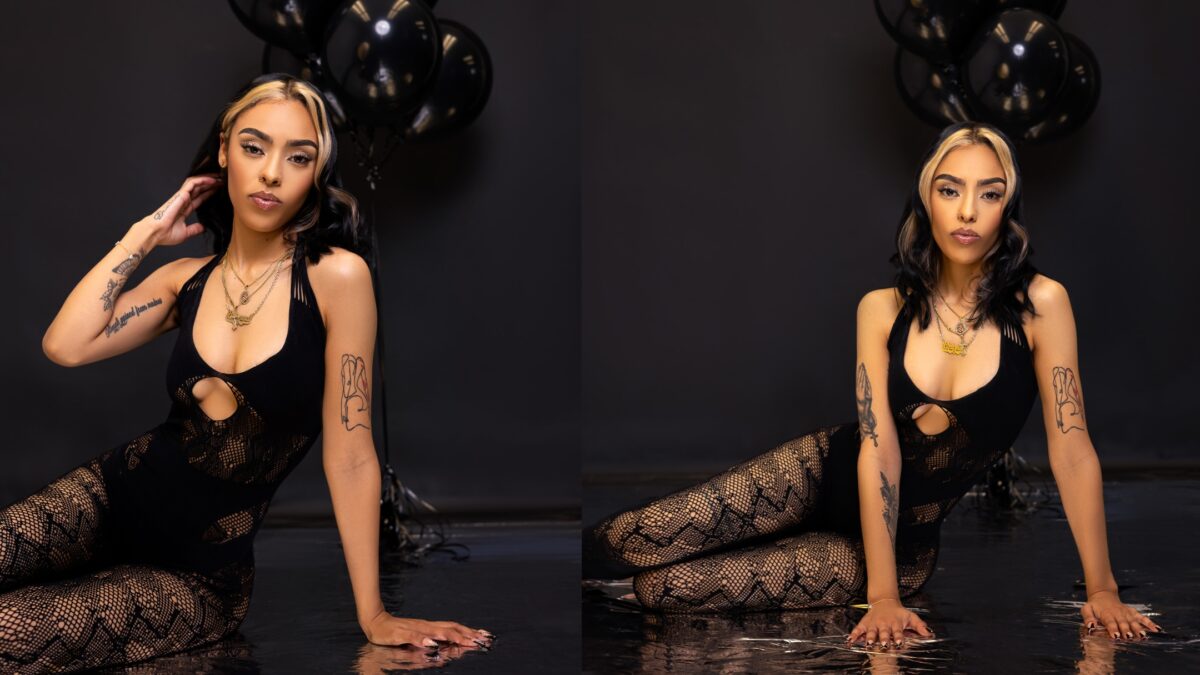
This is particularly helpful for portrait photography, where the focus is on the subject. By manipulating lighting and using professional equipment such as softboxes and strobes, you can create the desired mood and atmosphere for your portraits.
Also, photography studios offer a private and controlled setting, which can make your subjects feel more comfortable during the shoot.
On the other hand, outdoor photography allows you to take advantage of natural light and diverse locations.
Shooting on location also adds depth and variety to your images, giving them a unique look that’s hard to replicate in a studio.
Outdoor portraits benefit from the organic interaction between the subject and their surroundings, often resulting in more candid and genuine shots.
However, outdoor photography does come with its own challenges, such as working around weather conditions and finding the right timing for the perfect natural light.
Here are a few things to consider when deciding between a studio and outdoor shoot:
- Control: Studio photography gives you control over lighting, background, and distractions, while outdoor photography relies on the elements and location.
- Lighting: You can use professional lighting equipment in a studio to create your desired effect. While outdoor photography takes advantage of natural light, which can be unpredictable and requires planning. But you can also use select studio lights outside as well.
- Backdrop: Studios offer a variety of backdrops to choose from, whereas outdoor locations provide an endless amount of settings and landscapes to use as your backdrop.
- Creativity: Both studio and outdoor photography allow for creativity but in different ways. Studio shoots encourage control and precision, while outdoor shoots embrace spontaneity and natural elements.
- Cost: Studio rent, rentals, and equipment can be expensive, while outdoor locations may have permit fees or travel expenses.
Continuous Lighting vs. Flash Lighting
When it comes to photography lighting, you have two main options.
Continuous lighting and flash lighting.
Both types have their own unique advantages and limitations, depending on your specific needs and shooting preferences.
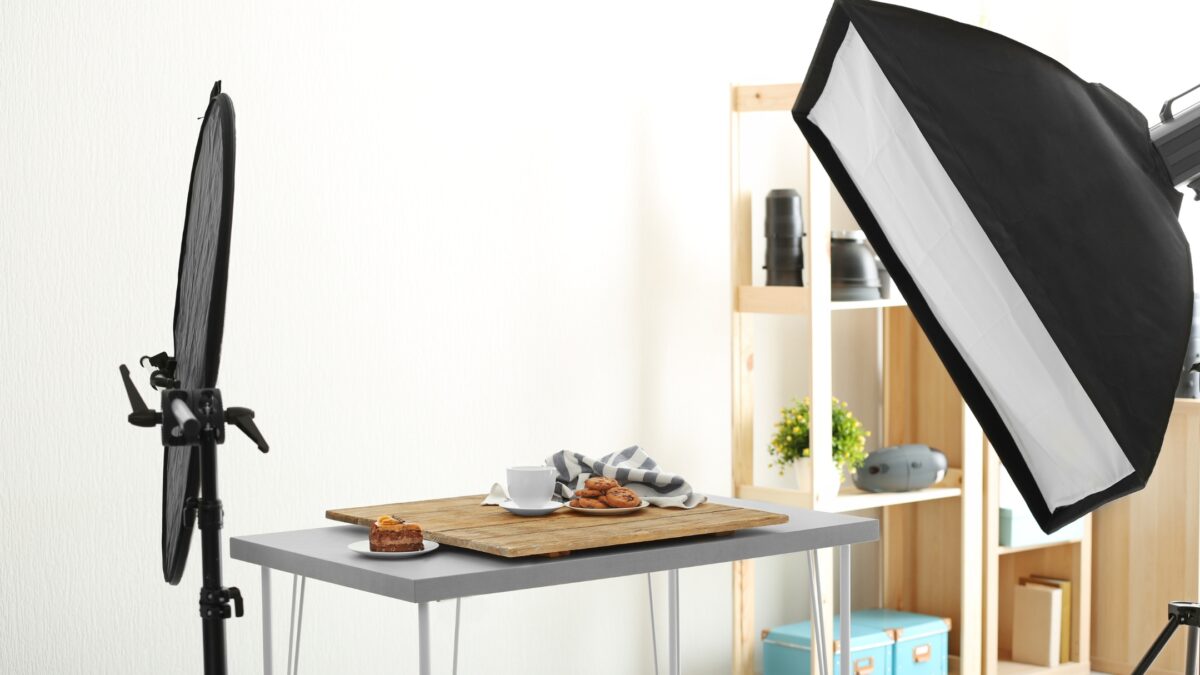
Continuous lighting, as the name suggests, provides a constant light source for your subject.
It comes in various forms, such as incandescent, LED, fluorescent, tungsten, and even plasma light sources. The main advantage of continuous lighting is that “what you see is what you get” — the light appears just as it will in the final image.
This can make it easier for you to adjust your camera settings, pose your subject, and compose your shot. But, continuous lights can generate heat and may not be as powerful as flash lights.
Flash lighting, on the other hand, provides short bursts of light when you take a photo.
It typically offers more power and the ability to freeze high-speed motion more accurately than continuous lighting source.
Flash lights can be either on-camera or off-camera, and they come with various features like TTL (Through The Lens) metering, HSS (High-Speed Sync), and adjustable recycle time.
Westcott's universal flash is compatible with multiple camera brands. And it's LCD touchscreen makes it user-friendly and easy for beginners to navigate and control flash settings.
TTL enables your camera to automatically control the power of your flash based on the information it gathers through the lens. This can make it easier for you to achieve the correct exposure in a variety of situations.
HSS is a useful feature when you want to shoot with a fast shutter speed (usually faster than 1/200s), allowing your flash to sync with the camera and still provide proper exposure. It’s really helpful when you’re trying to capture fast-moving subjects or balance ambient light with flash light.
Recycle time refers to how quickly your flash can be ready to fire again after taking a shot. Shorter recycle times mean you can take more photos in quick succession, which is helpful when capturing action or fast-paced events.
Detailed Features of Lighting Kits
Now let’s go over the key components that make up a successful lighting setup. In this section, I’d like to define various features, such as light-shaping tools, fill light, key light, color temperature, consistency, and wattage.
Light-shaping tools play a crucial role in controlling and directing the light to create the desired effect. These tools include softboxes, umbrellas, and reflectors, all of which help to diffuse or concentrate the light as needed. For instance, a softbox provides a soft and even output, while an umbrella reflects or diffuses light with different levels of intensity depending on its size and material.
Fill light is an essential tool in achieving proper lighting balance. It’s a secondary light source used to fill in shadows created by the key light, reducing contrast and revealing details in darker areas. You can create fill light using a softbox or an umbrella, or by bouncing light off a reflector.
Key light is the main light source, responsible for illuminating the primary subject and defining its overall shape and contour. It is usually placed at a 45-degree angle from the camera, creating depth and texture in the image. Good lighting kits often come with a powerful flash strobe to serve as the key light.
Color temperature refers to the warmth or coolness of a light source, measured in Kelvin (K). Different light sources have different color temperatures, which can affect the mood and atmosphere of your images. When choosing a lighting kit, look for options with adjustable color temperatures to match various conditions and workflows—such as the GODOX AD200 Pro.
Consistency is an important factor to consider when evaluating lighting kits. High-quality kits offer consistent output and color temperature, ensuring that your images maintain uniformity across different shots and setups. The Profoto B10 Kit is one such example.
Wattage refers to the power output of the light source. Higher wattage translates to brighter light output, which can be beneficial in various situations. But, higher wattage also means higher energy consumption and potential heat generation. A 600W lighting kit offers ample brightness for most studio and outdoor shoots, while still remaining energy-efficient.
How to Make the Most Out of Your Lighting Kit
Start with natural light: Before using artificial lights, make the most out of natural light. Observe how sunlight and moonlight affect your photography and us them to your benefit. Add elements like windows and reflectors to manipulate natural light for your shoots.
Familiarize yourself with your kit components: Study what comes with your lighting kit. Understand their strengths and limitations, and experiment with different combinations to find the best setup for your photography.
Master the fundamentals of light positioning: The position and angle of your lights play a big role in creating distinct moods and effects in your photos. Experiment with light positioning to learn how it affects shadows, contrast, and texture. A few light positions to start with are:
- Front lighting for bright, evenly lit subjects
- Side lighting to emphasize texture and depth
- Backlighting for silhouettes and dramatic effects
Adjust the intensity and color of lights: Understand how the intensity and color of lights can change the mood and atmosphere of your photos. Use light modifiers, filters, and gels to control these aspects of your lighting setup.
Practice and develop your unique style: As you gradually hone your skills, develop your personal photography style by experimenting with new techniques and lighting combos. And learn from other professionals through workshops and online resources.
Frequently Asked Questions About Photography Lighting Kits
Which portable lighting kits are best for outdoor photography?
When it comes to outdoor photography, portability and versatility are major factors. LED lights are a popular choice due to their lightweight design and ability to closely replicate natural light. Also, you may want to explore options such as light stands, umbrellas, and reflector kits for various outdoor settings.
What accessories come with a photography lighting kit?
Photography lighting kits typically include a combination of fixtures, stands, softboxes, umbrellas, diffusers, and reflectors. Some kits might also have remote controls, carrying cases, and other accessories to facilitate easy setup and breakdown. But, the exact accessories included may vary depending on the specific kit, so be sure to review the product description before making a purchase.
Is investing in expensive lighting kits worth it?
As you progress in your photography higher-end kits often provide better color accuracy, faster recycle times, and more consistent performance. Balance the cost of the kit with your needs and current budget.
What are the power and output options available for photography lighting kits?
Photography lighting kits come with different power and output options, including continuous and flash lighting. Continuous lighting provides a constant light source, while flash lighting emits a burst of light when the camera shutter is activated. The choice between continuous and flash lighting depends on your preferences and the subjects you’re photographing.
